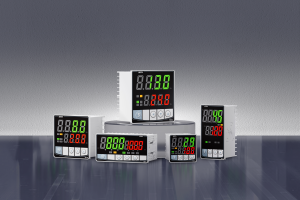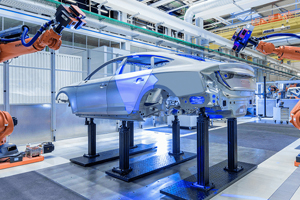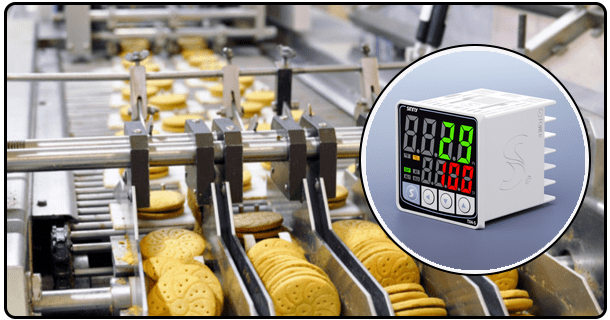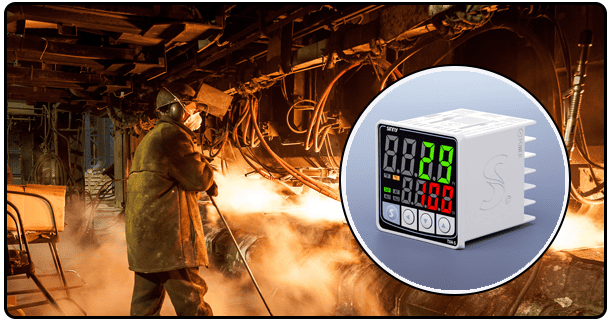Understanding fuzzy self-adaptive PID controllers
Learn how Fuzzy PID Controllers can enhance your temperature control system. Discover their
Since decades, the PID algorithm has been a cornerstone in temperature regulation. The PID control algorithm is based on a powerful yet simple principle. It compares the setpoint temperature to the measured temperature. Calculating the error and then adjusting the actuator, such as a cooler or heater, will minimize the error. PID combines three terms, Proportional Integral and Derivative. The derivative term helps dampen oscillations by predicting future errors, based on rate of change. Traditional PID controllers are highly effective for linear, well-behaved systems, but they have limitations when used in dynamic, complex environments.
The sensitivity of the PID to variations in process is a significant challenge. It is important to tune the three gain parameters of PID controllers (Kp. Ki. Kd) accurately.
This method can better capture real-world processes than mathematical models.
Adaptive control is a concept that complements fuzzy logic. The adaptive controllers automatically change their parameters to respond to any changes to the environment of the process or its dynamics. The controller can maintain its optimal performance as process characteristics change. The Fuzzy Self Adaptive PID Controller is a solution to challenging temperature control issues. It combines fuzzy logic and robust PID structure with an adaptive mechanism. The controller offers a combination of the accuracy of PID, the intelligence and flexibility of fuzzy logic with the robustness and performance of PID. The article provides a detailed overview of the advantages, design and operation of a system of temperature control.
1. The Core Components
No matter what control method is used, any temperature control system includes several components that work together. It is important to understand these components in order to fully appreciate the way the Fuzzy Self Adaptive PID Controller operates and interacts.
A closed loop feedback system is the basic structure of a system for temperature control. The temperature sensor is at the center of this feedback loop. It measures the temperature of the environment or system that needs to be regulated. Sensor accuracy, response time, and range are all critical, because they influence how accurate the controller can make adjustments. The most common types of temperature sensor include thermocouples (thermocouples), resistance temperature detectors(RTDs), thermistors. Each has its own features and is suitable for different temperatures ranges as well accuracy requirements.
Process is the name of the system, or environment that will be controlled. It could be an oven in an industrial plant, a chemical reaction, a space within a building or another area where temperature control is required. This includes the actuator type and complexity required.
The actuator implements the physical control actions dictated by controller. The actuator translates the output from the controller into an effect on the temperature of the process. Common actuators in heating applications include electric heaters or furnaces that burn fuel. Actuators for cooling may be fans, refrigeration units or evaporative coolers. It is important to match the actuator with the requirements of the process, such as power consumption, speed and physical limitations.
The controller is the unit that makes decisions for the system. The controller receives a temperature reading from the sensor and compares it with the setpoint temperature. It calculates any errors, then determines which control signal should be sent to the actuator. This is done by implementing a fuzzy logic inference to determine the PID gain based on current error, error rate and the sensor temperature. Then, using the gains, it calculates the output.
2. The feedback loop is the final component of the control system.
Fuzzy Self-Adaptive PID is based on the PID traditional algorithm. The simplicity and effectiveness of PID control makes it a popular technique for process control systems. This algorithm is based on the following three factors:
A proportional term (P): Output is proportional with the error. The difference between setpoint temperature and measured temperature is called the current output. The output is larger when the error is larger, and vice-versa.
Integral term (I): Output is proportional the integral error in time. The term is used to reduce steady state error by ensuring the temperature of the process reaches its setpoint even when the proportional terms alone are not able to do so.
Derived (D) term: Output is proportional with the rate of error change. This term helps predict future errors, and dampens oscillations to improve the stability of the system.
This is the mathematical representation for a standard PID control:
u(t) = Kp*e(t) + Ki*e(t)dt + Kd*de(t)/dt
where:
The control output is u(t).
The error is calculated by dividing the measured temperature (setpoint) by time t.
The gains Kp, Kd, and Ki are respectively the integral, derivative, and proportional gain. The gains determine how the controller responds and are therefore crucial parameters. They must be tuned carefully to ensure optimal performance.
The effectiveness of PID is dependent upon the accuracy in tuning these gain parameters. Manual tuning can require extensive trial and error adjustments and experience. Even then, it is difficult to achieve optimal performance in all conditions. The Fuzzy Self Adaptive PID Controller offers a major improvement in this area.
3. The Fuzzy Self Adaptive PID controller: Mechanism and Design
Fuzzy self-adaptive PID is a modern enhancement to the PID algorithm. The controller combines structured PID control with fuzzy logic's flexibility and intelligence, as well as an adaptive mechanism that continuously optimizes the performance of the controller. To understand how the controller works, you need to look closely at its components and its interaction.
A. Fuzzy Logic in PID Control
The Fuzzy Self Adaptive PID Controller retains, at its core, all the basic features of a PID, including input variables, out put variables and a calculation mechanism. It replaces conventional mathematical calculations by fuzzy logic inference.
Fuzzy Logic Controller: Inputs and Outputs are typically defined using linguistic terminology, for example "cold,""cool,""warm,"", "hot,"", "large,"", "medium,"and "small." These linguistic values are translated into numerical values by membership function. This describes the extent to which an input value is part of a fuzzy set. FLC uses a series of rules based on the inputs. The rules, which are often expressed as "if-then", connect the inputs with the outputs. The output from the fuzzy logic is then converted to a numeric value using a method called Defuzzification.
Process: This is a summary of how the Fuzzy Self Adaptive PID Controller operates. As inputs, the controller uses the temperature error currently e(t), and the change rate in the error de(t/dt. Fuzzification is the process of converting these inputs from numerical values into linguistic terms by using predefined membership functions. Fuzzy logic applies fuzzy rules to the inputs in order to calculate the values of the PID gain Kp, Kd, and Ki. The fuzzy logic outputs are defuzzified into precise numerical PID gain values. The tuned gains are used to determine the control output sent to actuator u(t).
Benefits: In this context, the primary advantage of fuzzy logic is that it can handle nonlinearities more efficiently than traditional PID controls. Fuzzy logic allows the control to be made based on the linguistic description of the process, which is more accurate than the mathematical model. The result is improved performance in particular for systems with non-linear relationships between control inputs, process outputs or those that are difficult to mathematically model.
4. Self Adaptive Mechanism allows for the controller to continually optimize itself. The mechanism adjusts PID gain online to ensure optimal performance, regardless of changes in process dynamics and environmental conditions.
Monitoring performance: To assess the self-adaptive system's performance, must be able to monitor its progress. The key performance indicators are monitored, such as Integral of Squared Errors (ISE), settling times (the amount of time required for the temperature of the process to stay within the specified tolerance range around the setpoint) and overshoots (the degree to which the setpoint has been exceeded prior to settling). These metrics are calculated continuously by the controller based on both the error signal as well as the response of the process.
Determine Adjustment Needs: The self-adaptive system determines if the PID gains that are currently being achieved are sufficient or whether adjustments are needed. The mechanism will trigger the adaptation process if the performance drops below a threshold that indicates the system's inefficiency. Specific criteria for triggering adaptations can be designed according to the needs of an application.
Tuning Online: After that, the self-adaptive system calculates new values of the PID gain. This is usually done again using fuzzy logic, but this time the adjustment values are based upon the error, the error rate and the deviation in performance. These fuzzy rules are designed to improve the performance of the system by increasing or decreasing the gains. The new gains will be implemented into the PID calculations, which continue to monitor the performance of the system and adjust as necessary. The online tuning ensures the controller always operates with the best gains available for the conditions.
5. Synergy of Fuzzy logic + Self-adaptation
Fuzzy logic provides intelligence to make adaptive decisions. It allows the controllers to deal with complex non-linear process and take decisions using linguistic rules. Self-adaptive mechanisms ensure that the controller continually optimizes, and adjusts the PID gain online in order to maintain optimal performance regardless of changes in process dynamics or environment conditions. Fuzzy logic provides intelligence to make adaptive decisions. It allows the controllers to deal with complex non-linear process and take decisions using linguistic rules. Self-adaptive mechanisms ensure that the controller continually optimizes its performance, and adjusts the PID gain online in order to maintain the optimal performance regardless of changes in process dynamics or environment conditions. The controller is able to perform better and be more robust than conventional PID controls.
System identification: Understanding the characteristics of temperature processes that need to be controlled is the first step. It is necessary to collect data about how the temperature process reacts to environmental changes and control inputs. The system identification process provides information that is needed to create an efficient controller, and determine the parameters of the adaptive and fuzzy logic mechanisms.
Designing Fuzzy Logic Control: In this step, you will design the fuzzy logic control itself. The fuzzy rules are then formulated. This involves defining input and output parameters, choosing appropriate membership functions and formulating the fuzzy logic. For those who do not have extensive knowledge of fuzzy logic, there are a variety of software tools that will help them design and implement fuzzy logic controllers.
Designing Self-Adaptive Logic In this step, the logic is designed to monitor and adjust PID gains in real time. It may be necessary to design fuzzy rules that determine the way gains are determined based on performance metrics, error rates and current errors.
Integration: Next, integrate the self-adaptive fuzzy PID controller into the rest of your temperature control system. Connecting the controller, sensor and actuator is required. Connect the controller to both the sensor and the actuator in order to transmit the signals.
Tuning and Testing: In the final stage, you will test and tune the system. It may be necessary to conduct simulations or experimentation in order to assess the performance of the system. It may be necessary to adjust the fuzzy rules or adaptation parameters to get desired results.
6. Illustration of an Application: Industrial Oven
A Fuzzy Self Adaptive PID Controller is a highly efficient solution for industrial ovens. In many industries, ovens are essential for drying, baking and curing processes. Accurate temperature control ensures product quality and efficiency. Fuzzy Self Adaptive PID Controller can handle complex heating profiles and maintain stability despite changes in load. It also responds to disturbances and improves product consistency.
Process description and controls for the oven:
Industrial ovens work by heating the materials inside to a certain temperature over a specified time. Depending on the product, the profile of the oven's temperature can be different. It may also be necessary to keep the temperature at a certain level to achieve the quality desired. Control requirements for the control include maintaining temperature accuracy, minimising temperature fluctuations, and ensuring even heating in the entire oven. Fuzzy Self Adaptive PID Controller can manage heating elements effectively to meet these requirements. The controller can change the output power based on current error in temperature and rate of error changes. Self-adaptive mechanisms ensure that the controller adjusts PID gains on the fly, optimising the control action based on the operating conditions. The result is improved product quality, lower energy consumption and better performance.
7. Real world benefits:
Implementing a Fuzzy PID Self-Adaptive controller offers benefits that go beyond the theoretical. It can offer tangible improvements for real-world application. Performance improvements translate into numerous advantages:
Superior performance at rejecting disturbances: Fuzzy self-adaptive PID controller is superior in its ability to reject disturbances. The controller can adjust its temperature setting quickly to account for external factors, such as changes in ambient temperatures or load variations. It is important to be able to keep temperatures stable despite external disturbances, especially for processes that are affected by temperature fluctuations. Reduced waste, increased yield and consistency in product quality are the results.
Improved handling of nonlinearities In real life, many processes display nonlinear behavior. This is because the relationship between control inputs to the output process is nonlinear. Fuzzy Self Adaptive PID Controller is especially well-suited to handle non-linearities. Fuzzy logic allows for the controller to better model non-linear relationship between control inputs, process outputs and their relationships.
Less sensitivity to process parameter changes: Thanks to the self-adaptive mechanisms, the controller will not be overly sensitive to any variations. The controller will maintain its optimal performance, even when the characteristics of the process change, such as due to changing load conditions or old components. This flexibility is an important advantage as it eliminates the need to manually intervene and provides consistent performance.
Faster response time and greater stability: Fuzzy self-adaptive PID can provide a faster response rate and more stability than conventional PIDs. The fuzzy logic component can model complex processes, and the self adapting mechanism continuously optimizes the control action. The result is improved product quality, lower energy consumption and better performance.
- Principles, components, and applications for process optimization
- Understanding temperature controllers with PID: An Expert's Guide to Process Control Optimization























